 |
The Women of WomanLore
WomanLore's one-woman performances are adapted directly from journals, autobiographies, and personal writings. WomanLore offers a complete theatrical experience, authentically costumed and designed, accurately evoking the era being portrayed.
Click a portrait to see
more information on
Mary Kingsley
Mother Jones
Gertrude Bell
Jane Addams
Alicia Appleman-Jurman
Elizabeth Cady Stanton
Juliette Kinzie
Clara Schumann
Juliette Gordon Low
Emily Dickinson
Gertrude Stein
|
 |
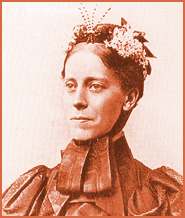 |
 |
Mary Kingsley (1862-1900)
was an intrepid Victorian explorer. She traveled to West Africa and lived among cannibals, was an ichthyologist and wrote two best selling books. "Travels in West Africa" is still #7 out of 100 best travel books of all time through the National Geographic Society.
"I respect African religious beliefs. I remember standing by a huge tree that the natives worshiped and I do not wonder they bow down to such a creation." |
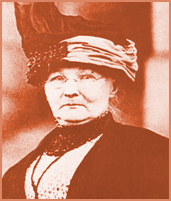 |
 |
Mother Jones (1830-1930)
was one of America's most effective and dynamic labor organizers. In 1903, she marched striking mill children from Philadelphia to President Roosevelt's home in Oyster Bay, Long Island. She wanted to draw the attention of the nation to the crime of child slavery.
"These children are to be the future citizens of America! Yes, pray for the dead and fight like hell for the living!"
|
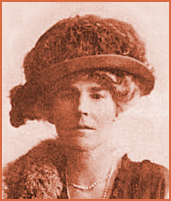 |
 |
Gertrude Bell (1868-1926)
was a wealthy Victorian woman who explored, mapped and excavated the world of the Arabs. She was the first woman to be taken into the British Imperial Service of Great Britain after WW1. She achieved nothing less than a miracle by creating the modern state of Iraq.
"Life! Life! The bountiful...the magnificent! I don't think anyone can travel here and come back the same."
|
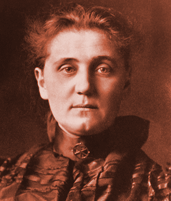 |
 |
Jane Addams
(1860-1935)
was a crusader for social justice, a dedicated American who devoted her life to caring for the underprivileged and oppressed and to fighting for the rights of workers, women and children.
"The good we secure for ourselves is precarious and uncertain until it is secured for all of us and incorporated into our common life."
|
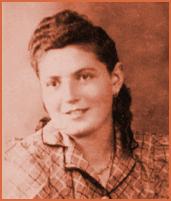 |
 |
Alicia Appleman-Jurman
(1930-2017)
was a uniquely courageous and unusually intuitive young Polish Jewish girl: She faced a terrifying and violent world and managed to retain her faith in humanity, in God, and in her people.
"I want to tell you the story of an important and painful part of my life. Through my story I wish to reach out, not only to survivors like myself, but to all people."
|
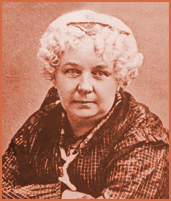 |
 |
Elizabeth Cady Stanton
(1815-1902)
An American social activist and
leading figure of the early woman's movement. Her Declaration of Sentiments, presented at the first woman's rights convention held in 1848 in Seneca Falls, New York, is credited with initiating the first organized woman's rights and woman's suffrage movements in the United States..
"The highest happiness of society and the individual is always in the same direction...life, liberty and the pursuit of happiness."
|
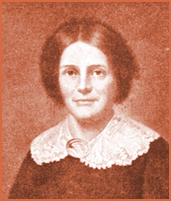 |
 |
Juliette Kinzie (1806-1870)
A well born and well bred New England girl. In 1830 she met the famous fur trader John H. Kinzie at her grandparents home in Boston. He asked her to be his wife and to share with him the great adventure of life in the wilderness.
"Since the time when I was a child growing up in New England, when I stood at my teacherís knee, and spelled out the long word Mich-i-li-mack-i-nac, that distant land, with its vast lakes, its boundless prairies, and its mighty forests, it had possessed a wonderful charm on my imagination."
|
 |
 |
Clara Schumann (1819-1896)
The prodigy daughter of a remarkable piano teacher, Frederich Wieck. Clara developed from a mere Wunderkind into a widely acclaimed virtuoso in her teens. The young Robert Schumann became a resident piano pupil at the Wieck household. Clara, a brilliant performer and Robert, a gifted composer fell deeply in love. Their marriage became one of the great true love stories of all time. Clara was eternally grateful for the art that was to sustain her through a lifetime of triumph and tragedy.
"You will never make an artist until you have loved and suffered! The playing needs that fire and depth of feeling which springs from the joys and sorrows of life. What a splendid thing to be an artist. I can turn all my suffering and joy into divine music."
|
 |
 |
Juliette Gordon Low (1860-1927)
A wealthy socialite of the United States and Great Britain, Juliette spent most of her life enjoying the recreations of the privileged classes. After meeting the founder of the Boy Scouts, Sir Robert Baden-Powell, she discovered a social cause to which she would devote the rest of her life. An enthusiastic organizer and fundraiser, she led the formation of the Girl Scouts of the USA in 1912. By the time of her death, the Girl Scouts had become a successful national organization with thousands of members.
"Ours is a circle of friendships united by ideals. Every little girl is a part and parcel of our great whole nation. One of our girls may someday alter the lives of hundreds of thousands of people."
|
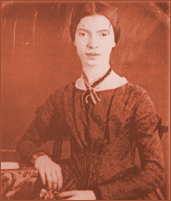 |
 |
Emily Dickinson (1830-1886)
Thought of an eccentric by the
locals, Emily became known for her penchant for white clothing and her reluctance
to greet guests, or later in life, even leave her room. Most of her friendships were
carried out by correspondence. Emily was a prolific private poet. Her poems
questioned the nature of immortality and death. Through nature and life she was
able to glimpse into a mystic dimension beyond worldly distractions. Emily is one
of the most loved and certainly the greatest American woman poet.
"I Dwell in Possibility—
A fairer House than Prose
More numerous of Windows—
Superior for Doors—"
|
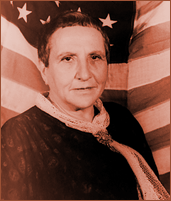 |
 |
Gertrude Stein (1874-1946)
was an American writer of novels, poetry and plays that eschewed the narrative, linear, and temporal conventions of 19th century literature. She was a fervent collector of modern art. For some 40 years, the Stein home at 27 Rue de Fleurs on the Left Bank of Paris was a renowned Saturday evening gathering place for expatriate American artists and writers, most notably Pablo Picasso.
"A writer should write with his eyes and
a painter paint with his ears." |
back to top |
 |


